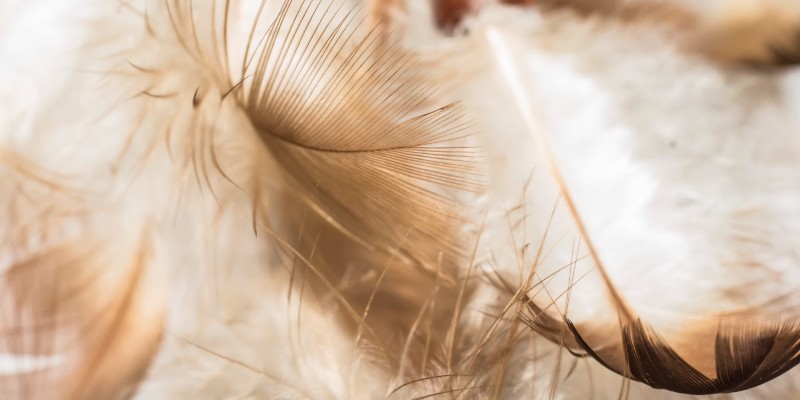Like little wreaths of funeral flowers, death crowns mark the passing of a loved one. But death crowns – seen as comforting to some, ominous and otherworldly to others – are not ordered up from a florist shop.
Just where death crowns do come from is a mystery, and an unsettling one at that.
If you’ve never seen a death crown, or angel crown for the more religiously inclined … well, that tracks. I’ve only ever seen a few and those were behind glass in an exhibit of death and funeral folklore at the Museum of Appalachia north of Knoxville. There’s no entry for death crowns in the Encyclopedia of Appalachia, which at 1,864 pages is the most authoritative source on Appalachian culture and society.
Death crowns figure into my obsession with death and dying, burials and cemeteries and what happens after we give up the ghost.
What are death crowns? To put it succinctly, they are tightly woven laurels of feathers, three or so inches around, that would be found in the feather pillows of the recently deceased. Sometimes they would be discovered when a survivor fluffed and smoothed the pillow of someone who had just died and felt a lump inside it.
Sometimes death crowns were found when survivors cut open a feather pillow for reassurance that their loved one was heaven-bound. Hence the “angel crown” terminology.
Death crowns have been reported for more than a century and a little-known belief system exists around them.
Sometimes they marked a mournful celebration of a person who passed away. Other times, they were a harbinger of death.
‘As though woven by delicate gremlins’
In January 1944. the Dayton Daily News reached into the past to explore the world of death lore in an article that began by citing witches’ hexes and voodoo dolls but quickly segued to death crowns.
“Mrs. Susie McIntosh, way up in the hills of Kentucky, near Irvin, decided to put a fresh tick (cover) on a pillow. The feathers floated around her as she reached her hand inside the old case. Her fingers touched something hard. Prickles of fear ran up her spine. She raked out the hard substance with a stick.
“There, in her hand, as though woven by delicate gremlins, round and solid, lay a Death Crown.”
Three people had died sleeping on the pillow, the woman said.
In the 1950s in Knoxville, newspaper columnist Bert Vincent featured recurring items in his column in the News-Sentinel. After he wrote about death crowns or angel crowns a couple of times, people would contact him after finding others in pillows. “TWO MORE ANGEL CROWNS FOUND IN PILLOWS,” Vincent’s column reported. A woman from Big Stone Gap, Virginia, had found two angel crowns in pillows her recently deceased mother-in-law had used.
Vincent was still writing about death crowns in 1963, in a column item right above a report on a 52-inch squash.
“Of course, now, if you must be hard and so practical that you demand a practical explanation, it is that feathers in a pillow tend to mat when rolled on and pressed for a length of time,” he wrote. “But really, when you examine one of these crowns closely, you wonder how it could just sort of accidentally happen. The feathers are put together so perfectly that you can pick it up and handle it without losing a feather.”
‘This person would soon die’
Death folklore, although not about angel crows, is its own section of the Encyclopedia of Appalachia. From the death watch, when family and friends would stand by as a loved one approached the end of life, to the ringing of a bell and hanging of a black wreath on the door, people would prepare for death and react to death.
Even the wake, which the encyclopedia credits to the Scots-Irish, my forebears, was considered a folkloric practice meant to “wake” the dead. But the wake had practical purposes as well, not only to host a gathering of loved ones but to ward off “cats, rats and insects” from getting at the corpse.
But death crowns are largely unacknowledged.
In the Museum of Appalachia, founded by John Rice Irwin and now a Smithsonian institution, Irwin’s collection of death crowns – alternately called angel crowns or even angel of death crowns – are alongside such grim collectibles as a horse-drawn funeral carriage and child-sized coffin.
A long explanation, signed by Irwin – who died in January 2022 – noted that a death crown “indicated that the deceased person, in whose pillow it was found, had gone to heaven. Others believe that if such an object was found in the pillow of a sick person, it meant that this person would soon die.”
Irwin noted that when a friend had shown him a death crown, he was embarrassed to admit he’d never heard of one. “But I found that no one else had heard of it either.”
“I do not assume that this was a commonly held belief in Appalachia (although it might have been), nor do I assume that such a belief is peculiar to this region. Indeed, I’m informed that one branch of the National Museum of Wales in Cardiff has a display of angel crowns. Many people from this area, including this writer, can claim a Welsh ancestry,” he wrote.
Among the several angel crowns on display at the museum is one from the pillow of William H. Rule, who died in 1968. Rule’s angel crown was the museum’s artifact of the week in August 2022.
New death crowns ‘almost every night?’
Although death crowns seem like a natural folklore artifact to include in a book, especially a novel, I’ve been unable to find references to the phenomena there.
There is a long-standing reference to feather crowns in news reporting. The University of Wisconsin-Madison’s Dictionary of American Regional English cites the angel crown or angel wreath going as far back as 1891 editions of the Ottawa Daily Republican newspaper, which recounted a man who was “taken sick and could always hear the witches singing about him … He did not dare to sleep on a bed because he found his bed and pillows full of feather crowns.”
Another man noted that feather crowns were being placed in his wife’s pillows “almost every night.”
In 1964, the (Nashville) Tennessean quoted a woman who noted that in 1941, her husband had pneumonia. “But after he recovered I found a perfect feather crown in the pillow he had used during his illness. Yet this man is living and hasn’t been sick since.”
The dimming of death folklore – not to mention less frequent use of feather pillows – has drastically reduced reports of death crowns.
The Old Farmer’s Almanac noted that while death crowns had been interpreted as signs of impending death and an indicator that the deceased had gone to heaven, the almanac had a theory as to why angel crows were found much less frequently in modern times: fewer people were going on to their heavenly reward.

















